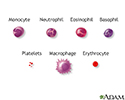Agranulocytosis
Granulocytopenia; Granulopenia
White blood cells fight infections from bacteria, viruses, fungi, and other germs. One important type of white blood cell is the granulocyte, which is made in the bone marrow and travels in the blood throughout the body. Granulocytes sense infections, gather at sites of infection, and destroy the germs.
When the body has too few granulocytes, the condition is called agranulocytosis. This makes it harder for the body to fight off germs. As a result, the person is more likely to get sick from infections.
Causes
Agranulocytosis may be caused by:
- Autoimmune disorders
- Bone marrow diseases, such as myelodysplasia or large granular lymphocyte (LGL) leukemia
- Certain medicines used to treat diseases, including cancer
- Certain street drugs
- Poor nutrition
- Preparation for bone marrow transplant
- Problem with genes
Symptoms
Symptoms of this condition may include:
Exams and Tests
A white blood cell differential test will be done to measure the percentage of each type of white blood cell in your blood.
Other tests to diagnose the condition may include:
- Bone marrow biopsy
- Biopsy of mouth ulcer
- Neutrophil antibody studies (blood test)
Treatment
Treatment depends on the cause of the low white blood cell count. For example, if a medicine is the cause, stopping or changing to another medicine may help. In other cases, medicines to help the body make more white blood cells will be used.
Outlook (Prognosis)
Treating or removing the cause often results in a good outcome.
Prevention
If you are having treatment or taking medicine that could cause agranulocytosis, your health care provider will use blood tests to monitor you.
References
Cook JR. Bone marrow failure syndromes. In: Hsi ED, ed. Hematopathology. 3rd ed. Philadelphia, PA: Elsevier; 2018:chap 5.
Klokkevold PR, Mealey BL. Influence of systemic conditions. In: Newman MG, Takei HH, Klokkevold PR, Carranza FA, eds. Newman and Carranza's Clinical Periodontology. 13th ed. Philadelphia, PA: Elsevier; 2019:chap 14.
Sive J, Foggo V. Haematological disease. In: Feather A, Randall D, Waterhouse M, eds. Kumar and Clarke's Clinical Medicine. 10th ed. Philadelphia, PA: Elsevier; 2021:chap 17.
Review Date: 4/29/2022









